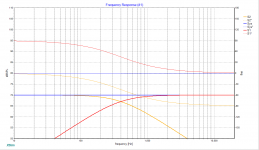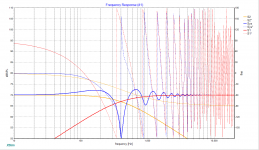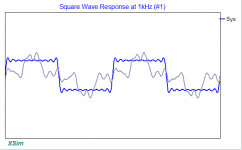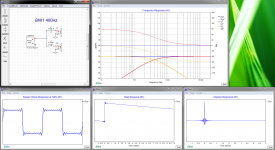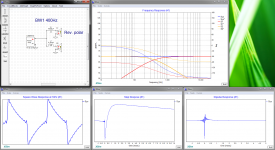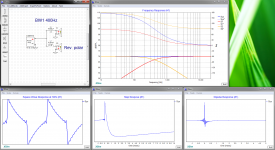Ok, I get it now - the time alignment also controls the phase shift which causes the bump or dip if not set correct. I should go back to my old trick of adjusting time alignment with a tone set at XO freq, flip polarity on one driver and adjust delay until obtain deepest null at XO freq, then flip polarity back. That way, time alignment is at XO freq and that makes it balance above and below XO point. That's what I did on my Trynergy. It was much easier to see with 4th order though. 1st order hardly makes difference or deep notch.
Exactly! when they aren't time aligned then the signals have differing arrival times or...phase. It can either be done electrically or acoustically by physically moving the drivers.
Never done it with a tone at a single frequency, but if it works then whatever. I would do it as a sweep so you can see the effect on the rest of the response too. Because my concern based on your FR measurements is more the cancellation on either side of the xo than the null. The null will allow you to see when you're getting there.
Also, the deepest null does not always equate to the best phase tracking on either side of the crossover, just right at the crossover, but we'll deal with that later.
Never done it with a tone at a single frequency, but if it works then whatever. I would do it as a sweep so you can see the effect on the rest of the response too. Because my concern based on your FR measurements is more the cancellation on either side of the xo than the null. The null will allow you to see when you're getting there.
Also, the deepest null does not always equate to the best phase tracking on either side of the crossover, just right at the crossover, but we'll deal with that later.
What is the reason you want a Q of 1 on the rear chamber? I thought 0.71 was the goal?
The reason for the high Qtc is to control driver excursion. With Qtc=1, you are pretty much quanteed that the excursion will reach a maximum shortly after cutoff and flatten out the rest of the way down. Also, the cutoff will be abrupt with little overshoot (~1dB).
BTW I misquoted the volume of the Q=1 box for the 10F. It is 0.4l.
Bob
Byrtt, did you build the same speaker with these drivers?
If you reversed polarity you should see a null at the crossover point and at least a couple of octaves each side with BW1. Phase and step and everything else will get out of wack of course
For the build have only financed 10F couple weeks ago before that used TC9FD and a exercise setup seen post 63/106 now running 10F. Like sound from sealed and the soft BW1.
XSim at Picture 1 show standard polarity and blue line linear system phase sum then checked the reverse polarity and the always 90º apart for BW1 counteracts so we can switch tweeter or woofer or both but never reach 180º apart to cancel out they just get different system phase where transient response is ruined. The model run at 400Hz XO point without a system passband set, then when sat sweeping tweeter in front or woofer behind at precise 25" picture two happens. That must could be used to if in reality lets say the suchout happens at 28" the difference at 3" must be driver offset. The offset takes hard on the square wave : )
Attachments
Last edited:
Asymmetric BW1 XO
Here is my latest effort with trying to clean up the responses so that they are closer to the ideal slopes. Using mild EQ, I adjusted the raw no-filters responses from both the bass driver and the fullrange so that they were as flat as possible before applying the HP and LP filters of the BW1 XO. The best compromise to get a fairly low symmetric acoustic XO was to make the electrical XO asymmetric. I ended up with 350Hz BW1 for the RS225 and 200Hz BW1 for the 10F/8424. I think the rear chamber is in fact, too small to allow enough bass extension below 400Hz. I suppose one could apply a Linkwitz transform on the 10F as well?
Here is the acoustic XO which is effectively at 450Hz (1/3rd oct smoothed for clarity of where the XO is at):
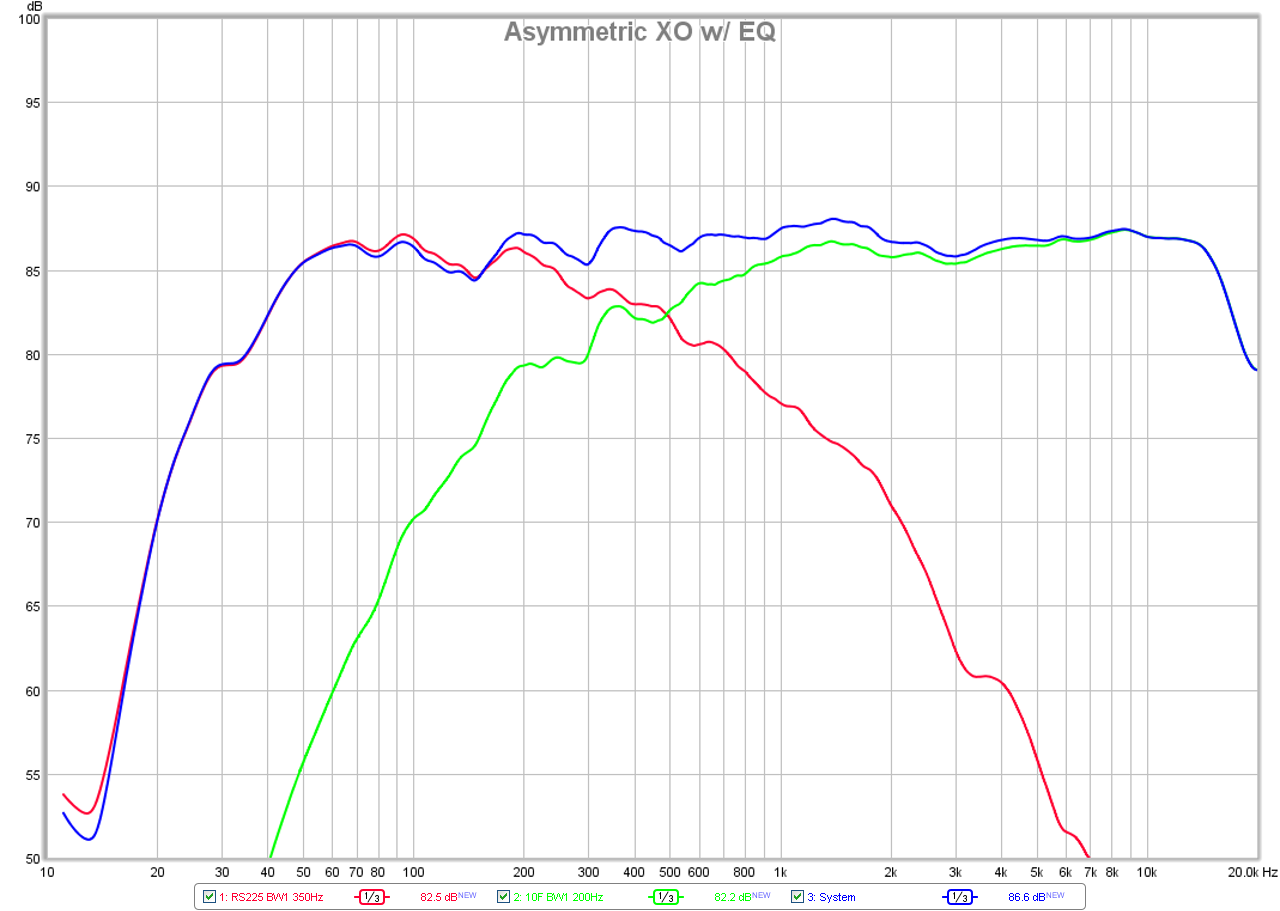
Here is the high resolution frequency response at 2dB/div and the absolute phase with 4ms gate:
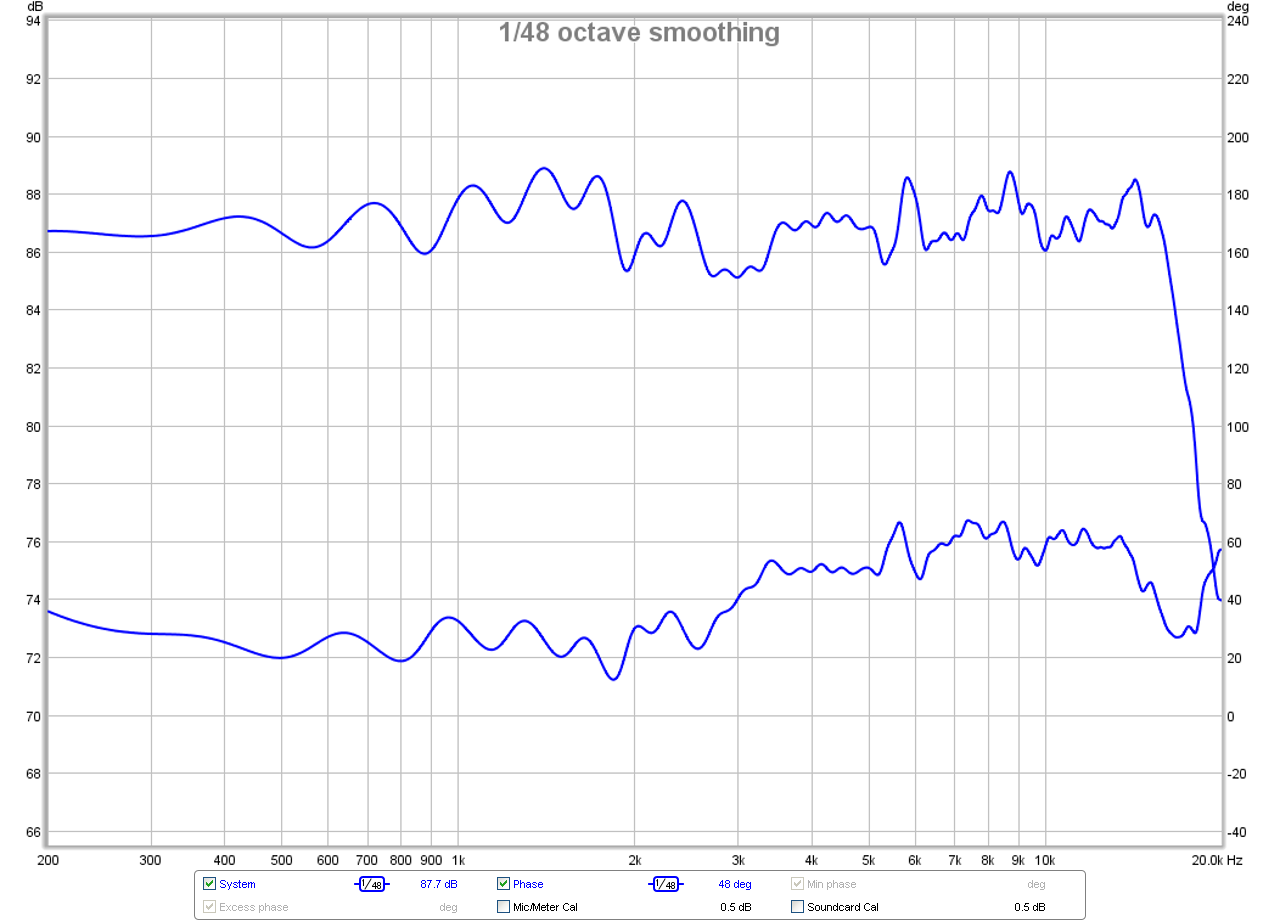
Here is the impulse response and step response:
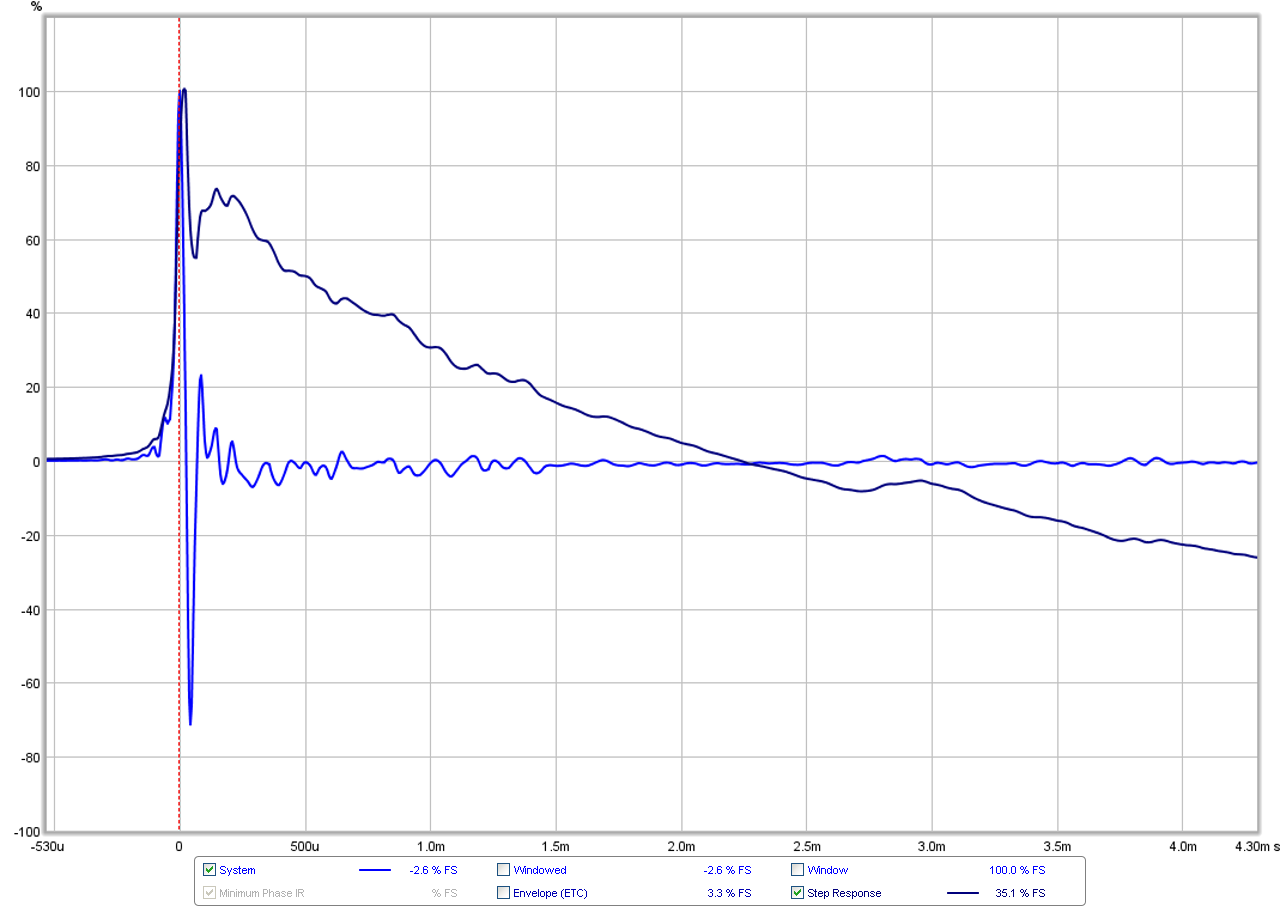
Here is the ungated response and absolute phase (about +/- 17 deg from 90Hz to 20kHz):

Here is the harmonic distortion:
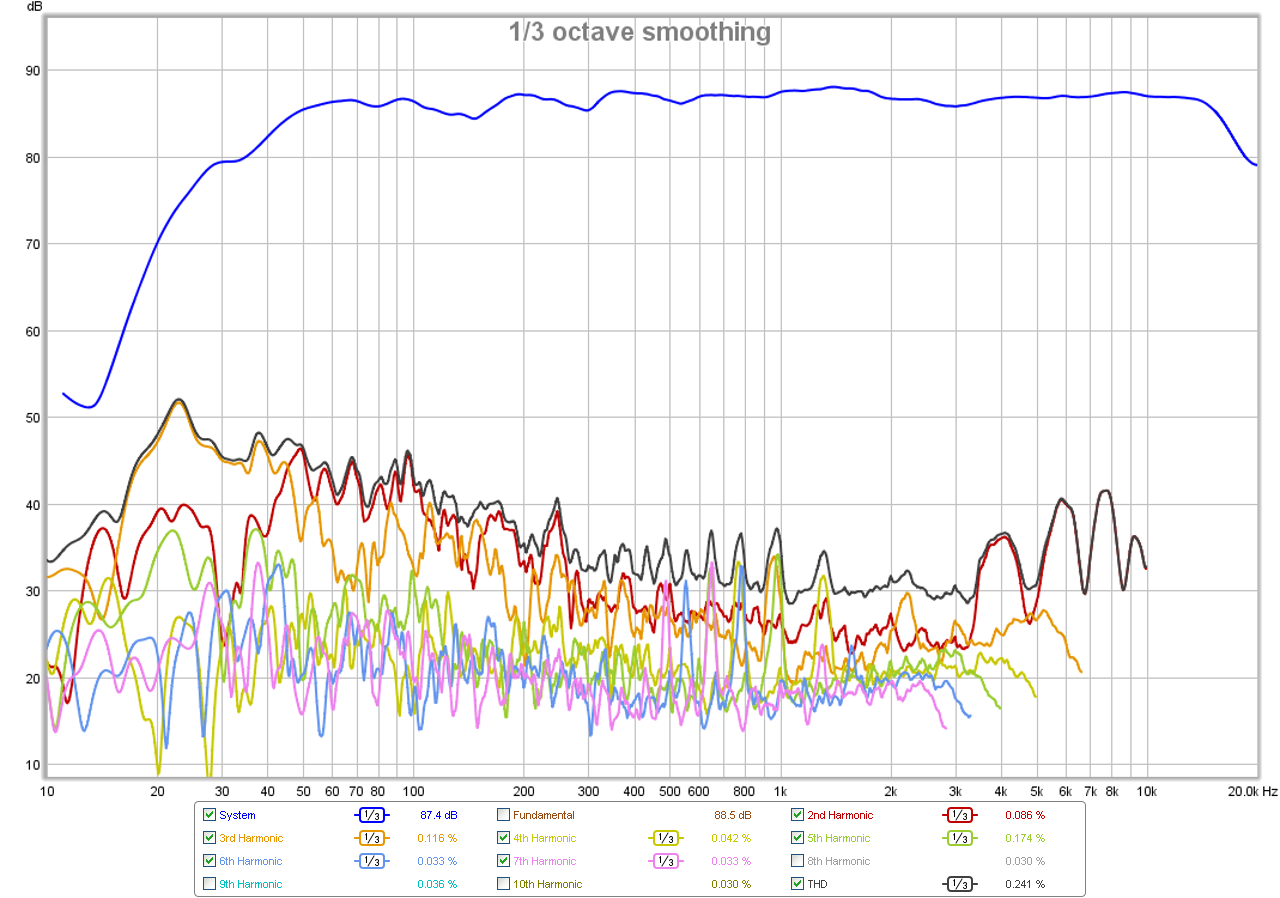
Measurements at 0.5m distance away.
Now just starting to listen to test tracks with this configuration. So far sounds very good, I think there is more clarity now with less of the woofer leaking through into the highs.
Here is my latest effort with trying to clean up the responses so that they are closer to the ideal slopes. Using mild EQ, I adjusted the raw no-filters responses from both the bass driver and the fullrange so that they were as flat as possible before applying the HP and LP filters of the BW1 XO. The best compromise to get a fairly low symmetric acoustic XO was to make the electrical XO asymmetric. I ended up with 350Hz BW1 for the RS225 and 200Hz BW1 for the 10F/8424. I think the rear chamber is in fact, too small to allow enough bass extension below 400Hz. I suppose one could apply a Linkwitz transform on the 10F as well?
Here is the acoustic XO which is effectively at 450Hz (1/3rd oct smoothed for clarity of where the XO is at):

Here is the high resolution frequency response at 2dB/div and the absolute phase with 4ms gate:

Here is the impulse response and step response:

Here is the ungated response and absolute phase (about +/- 17 deg from 90Hz to 20kHz):

Here is the harmonic distortion:

Measurements at 0.5m distance away.
Now just starting to listen to test tracks with this configuration. So far sounds very good, I think there is more clarity now with less of the woofer leaking through into the highs.
Attachments
-
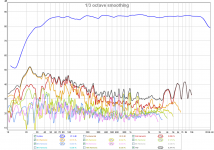 10f-rs225-bw1-405hz-asym-lt-hd.png340.1 KB · Views: 1,084
10f-rs225-bw1-405hz-asym-lt-hd.png340.1 KB · Views: 1,084 -
 10f-rs225-bw1-405hz-asym-lt-phase.png95.5 KB · Views: 1,179
10f-rs225-bw1-405hz-asym-lt-phase.png95.5 KB · Views: 1,179 -
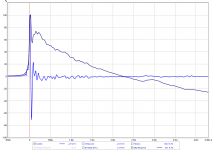 10f-rs225-bw1-405hz-asym-lt-ir-sr.png87.7 KB · Views: 1,084
10f-rs225-bw1-405hz-asym-lt-ir-sr.png87.7 KB · Views: 1,084 -
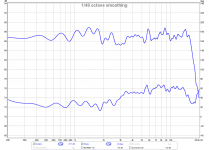 10f-rs225-bw1-405hz-asym-lt-fr-gated-4ms.png104.2 KB · Views: 1,415
10f-rs225-bw1-405hz-asym-lt-fr-gated-4ms.png104.2 KB · Views: 1,415 -
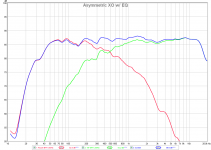 10f-rs225-bw1-405hz-asym-lt-xo.png104.6 KB · Views: 1,104
10f-rs225-bw1-405hz-asym-lt-xo.png104.6 KB · Views: 1,104
Last edited:
For the build have only financed 10F couple weeks ago before that used TC9FD and a exercise setup seen post 63/106 now running 10F. Like sound from sealed and the soft BW1.
XSim at Picture 1 show standard polarity and blue line linear system phase sum then checked the reverse polarity and the always 90º apart for BW1 counteracts so we can switch tweeter or woofer or both but never reach 180º apart to cancel out they just get different system phase where transient response is ruined. The model run at 400Hz XO point without a system passband set, then when sat sweeping tweeter in front or woofer behind at precise 25" picture two happens. That must could be used to if in reality lets say the suchout happens at 28" the difference at 3" must be driver offset. The offset takes hard on the square wave : )
I'm not sure how the sim works, but you shouldn't be seeing that kinda comb filtering response with the polarity reversed. If you see a perfectly flat line and perfect slopes like that then I would think that you'd see a perfect null. Have you adjusted your acoustic centers. I'd start at maybe -15 to -18mm on the woofer.
Here is my latest effort with trying to clean up the responses so that they are closer to the ideal slopes. Using mild EQ, I adjusted the raw no-filters responses from both the bass driver and the fullrange so that they were as flat as possible before applying the HP and LP filters of the BW1 XO. The best compromise to get a fairly low symmetric acoustic XO was to make the electrical XO asymmetric. I ended up with 350Hz BW1 for the RS225 and 200Hz BW1 for the 10F/8424. I think the rear chamber is in fact, too small to allow enough bass extension below 400Hz. I suppose one could apply a Linkwitz transform on the 10F as well?
Here is the acoustic XO which is effectively at 450Hz (1/3rd oct smoothed for clarity of where the XO is at):

Here is the harmonic distortion:

Measurements at 0.5m distance away.
Now just starting to listen to test tracks with this configuration. So far sounds very good, I think there is more clarity now with less of the woofer leaking through into the highs.
Good job man! I applaud you for being flexible and willing to try it. It's looking much better! I have a couple more suggestions 😀
1) the phase is a lot better overall. You still show some cancellation between about 50-150Hz, but getting much better. Did you try adjusting the 10F delay with polarity switched? Can you post graph with opposite polarity?
2) It looks a bit hot in the midrange. You might try applying a cut of a couple decibels to the 600-2000 area. Maybe up to 4db or so; remember that perfectly flat frequency response is not necessarily the top priority. Adjust this area down until the timber and balance of voices and instruments sounds correct.
3) The woofer breakup looks much better controlled to me in the sense of it being down from the fundamental. It's still only 25db down at 3k which might be borderline. Take a look at the 3rd order distortion peak at 1k. Remember I mentioned that this is likely caused by the start of the breakup at 3K. Also, the rising distortion in the 3500-10K range maybe from the woofers breakup or it could be a measurement artifact/limitation.
4) The reason you can't hit first order at 350 with the 10F is because of it's native response or the enclosure limiting the low end as you say. Hitting 1st order slopes is very hard. Even second order slopes are often difficult to achieve even with well behaved drivers because once you apply a xo they are already rolling off faster than those shallow slopes. This is especially true with tweeters and a very low high pass on small midrange/fullrange drivers with an fs around 150Hz. Not sure what to tell you about that. You could try a bit of boost above fs I suppose, but I think you'll start stressing that little driver. I definitely wouldn't use an LT as that seem pretty extreme.
I think the better option would be to try the aperiodic vent and see if that helps extend the low end while at the same time damping the resonance.
A first order crossover at 200Hz with the 10f sounds awlfully low to me, but I suppose it'll depend on your listening levels.
Actually, looking at the first graph again, I would recommend just raising the 10f crossover a bit. I'd bring it up to 35-400 regardless of target slope. that should accomplish a number of things at once.
1)It'll reduce the 600-2000 level down to where it should be. It's tempting to keep this area up because it seems like you're getting a ton of vividness and detail, but I usually find that detail improves when the speaker is balanced and isn't as bright.
2) It should fix that last little bit of phase cancellation that you have from 50-150
3) It'll reduce the strain on the 10f and make it sound clearer and cleaner by reducing distortion
You still might need a bit of downward peq at around 1500 after raising the xo. I'd adjust the xo first and see where you're at
1)It'll reduce the 600-2000 level down to where it should be. It's tempting to keep this area up because it seems like you're getting a ton of vividness and detail, but I usually find that detail improves when the speaker is balanced and isn't as bright.
2) It should fix that last little bit of phase cancellation that you have from 50-150
3) It'll reduce the strain on the 10f and make it sound clearer and cleaner by reducing distortion
You still might need a bit of downward peq at around 1500 after raising the xo. I'd adjust the xo first and see where you're at
Acoustic XO is at 550Hz now
SATX,
I had a few minutes to try your suggestion before heading out today. I moved the electrical XO of the 10F up to 350Hz, and padded it down by -1.6dB. Everything else left as is. I think it helped to reduce the HD in the 100-300Hz range. I will show the HD for the woofer and fullrange separately so you can see what the contributions are. The RS225 is quite clean - all those little HD peaks above 1kHz are due to the 10F. Playing at a reasonable 85dB level the HD is quite respectable.
Here is new acoustic XO, the lighter colors are the old, brighter colors are the new, 1/3rd oct smoothing for clarity of where acoustic XO point is (circa 550 Hz now):
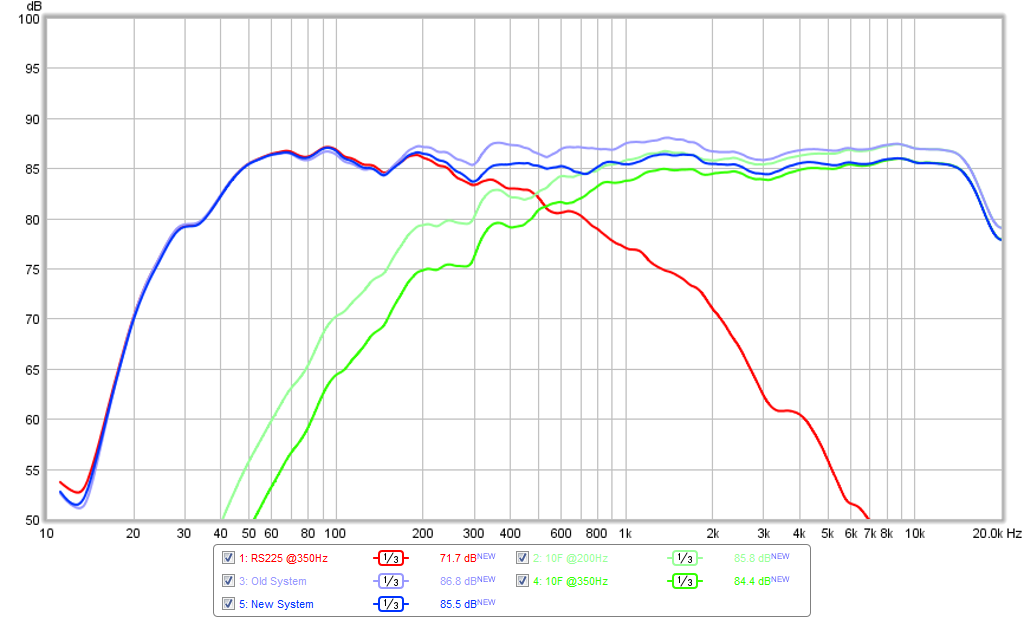
Here is absolute phase over full range:
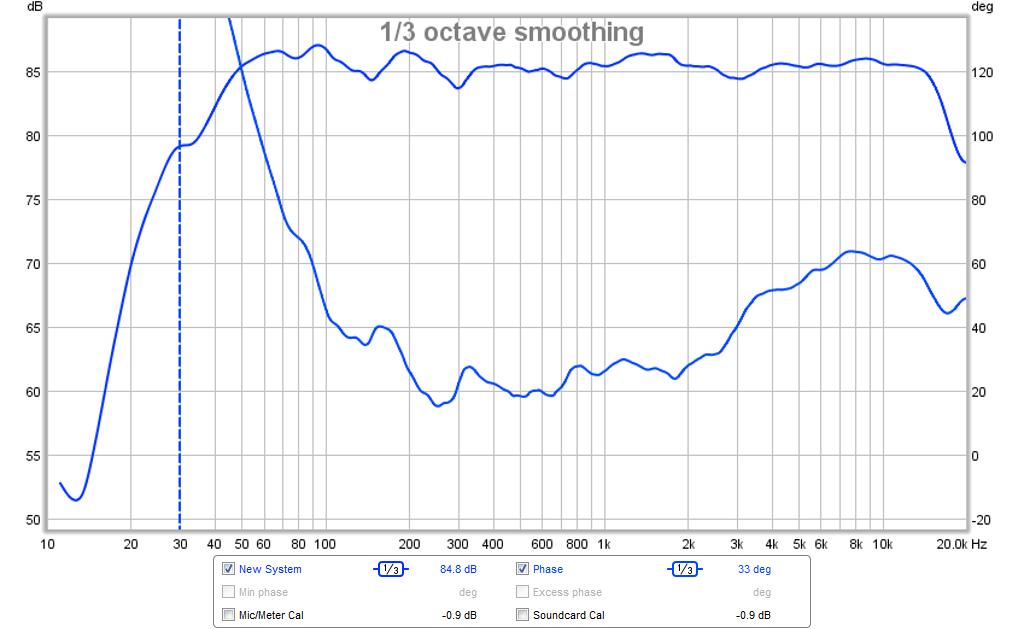
Here is the absolute phase with high resolution vertical scale (2dB/div) and 1/48th oct smoothing and 4ms gate applied:
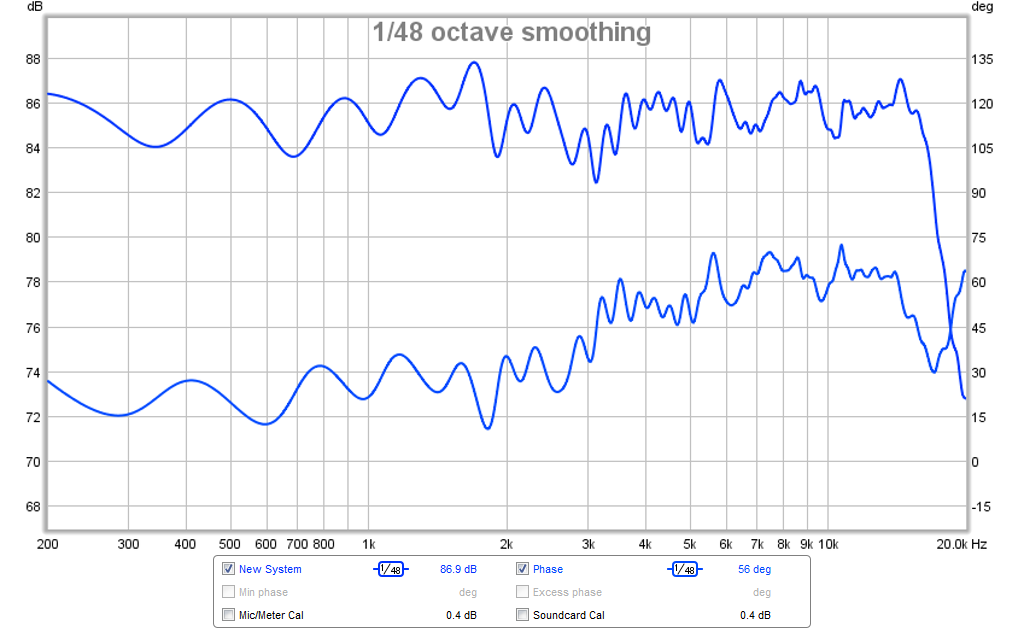
Here is the HD of the RS225-8:
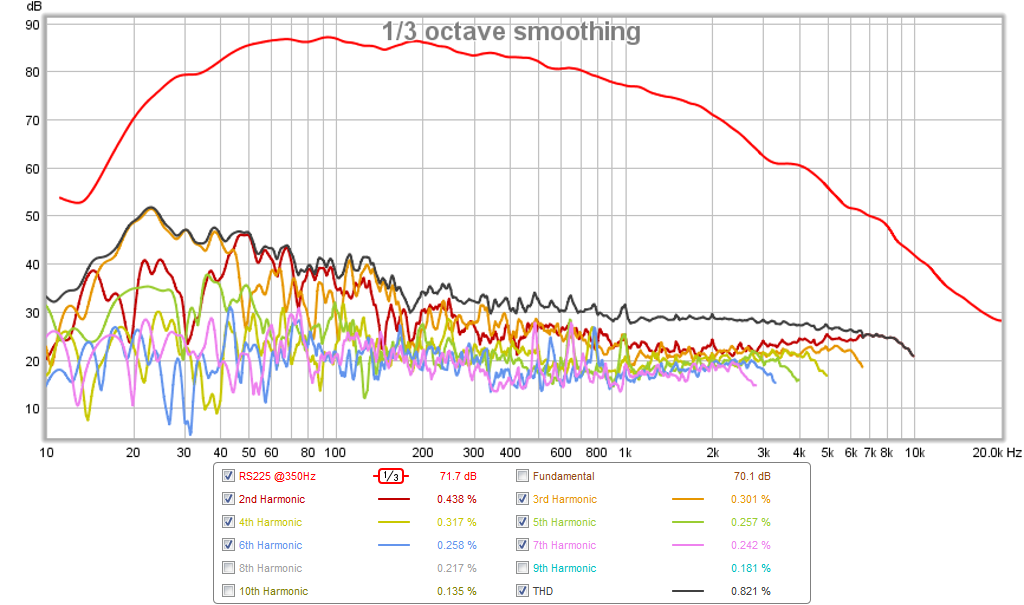
Here is the HD of the 10F/8424:
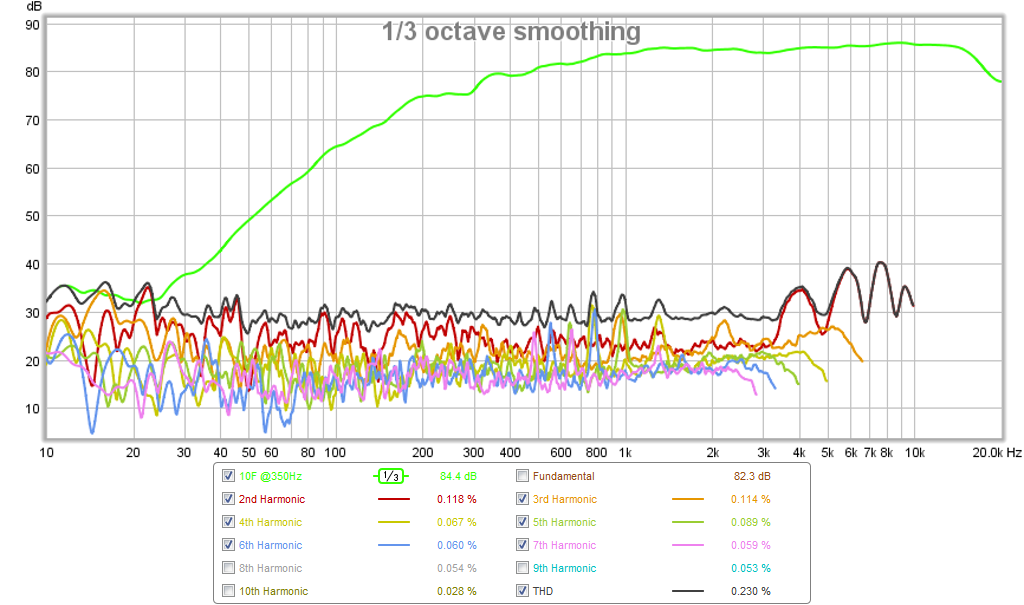
Here is overall system HD:
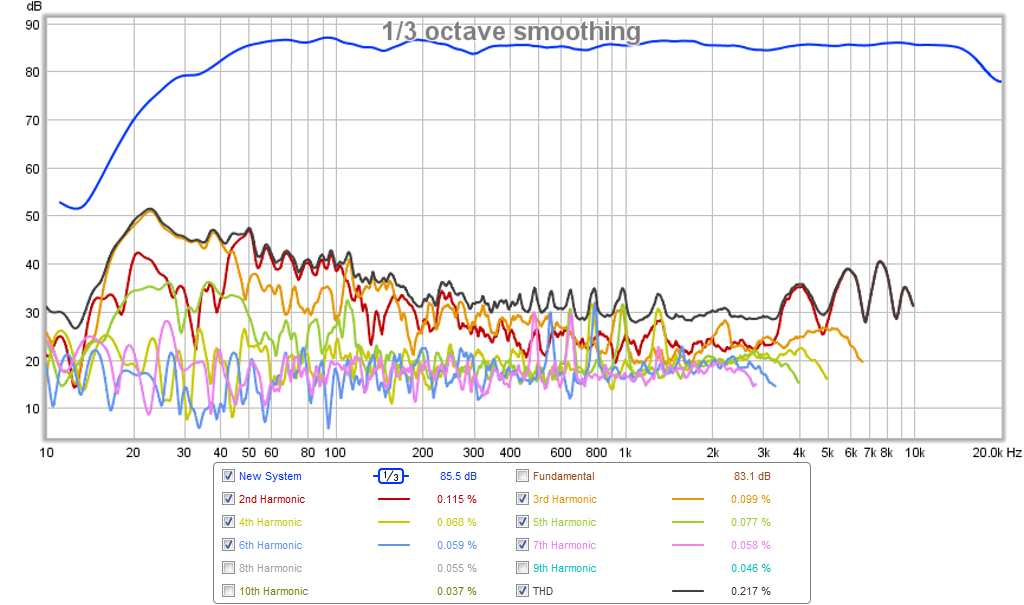
Here is impulse response and step response:
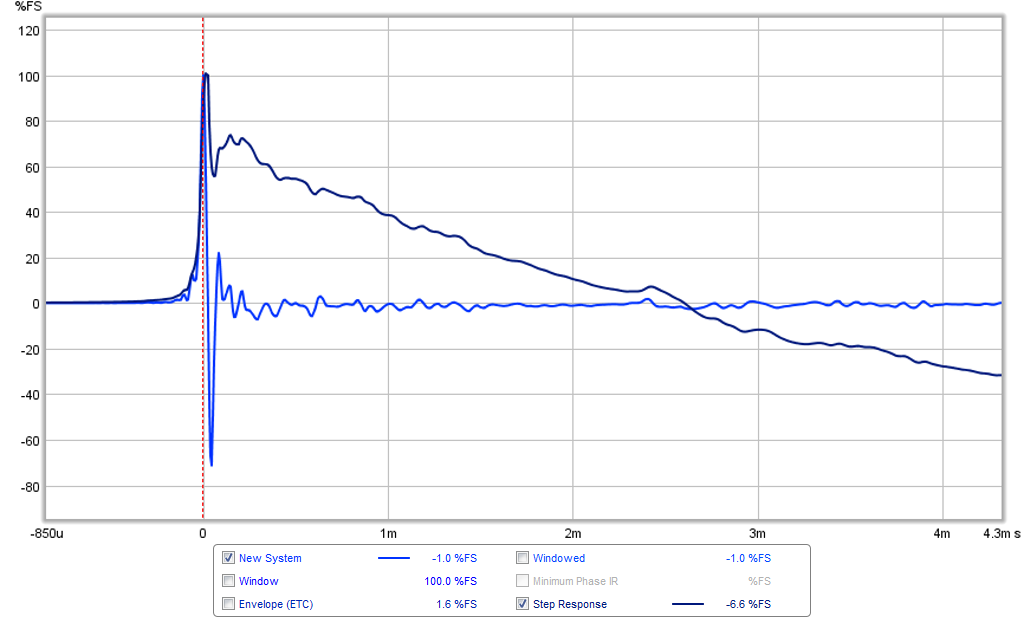
Not sure if this means anything but here is CSD for system with 10ms window and 0.2ms rise time:
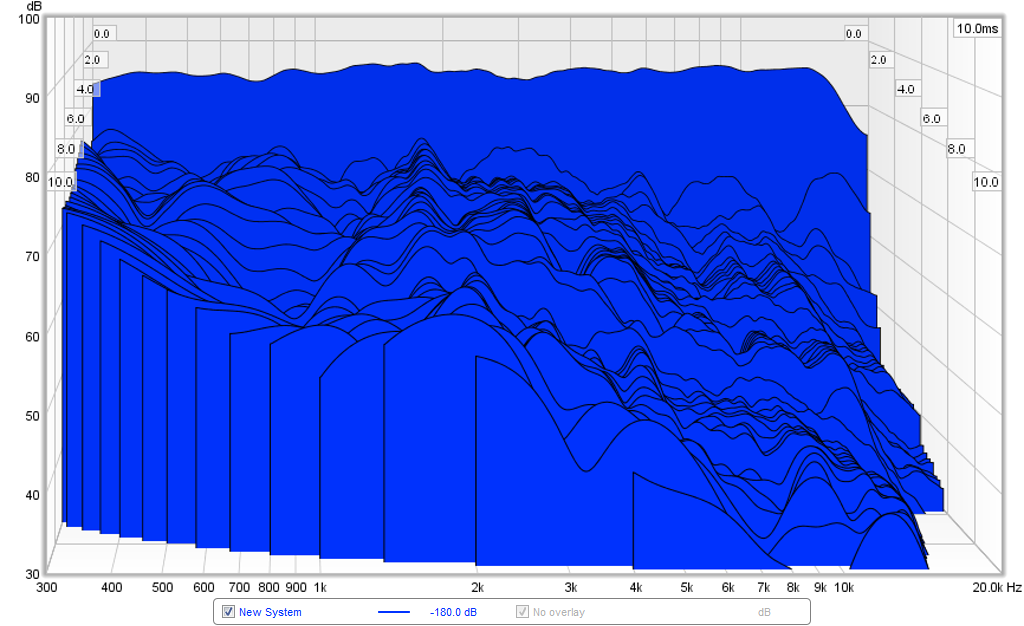
SATX,
I had a few minutes to try your suggestion before heading out today. I moved the electrical XO of the 10F up to 350Hz, and padded it down by -1.6dB. Everything else left as is. I think it helped to reduce the HD in the 100-300Hz range. I will show the HD for the woofer and fullrange separately so you can see what the contributions are. The RS225 is quite clean - all those little HD peaks above 1kHz are due to the 10F. Playing at a reasonable 85dB level the HD is quite respectable.
Here is new acoustic XO, the lighter colors are the old, brighter colors are the new, 1/3rd oct smoothing for clarity of where acoustic XO point is (circa 550 Hz now):

Here is absolute phase over full range:

Here is the absolute phase with high resolution vertical scale (2dB/div) and 1/48th oct smoothing and 4ms gate applied:

Here is the HD of the RS225-8:

Here is the HD of the 10F/8424:

Here is overall system HD:

Here is impulse response and step response:

Not sure if this means anything but here is CSD for system with 10ms window and 0.2ms rise time:

Attachments
-
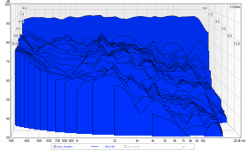 10f-rs225-fast-bw1-550hz-acoustic-system-csd-10ms-window.png231.5 KB · Views: 1,049
10f-rs225-fast-bw1-550hz-acoustic-system-csd-10ms-window.png231.5 KB · Views: 1,049 -
 10f-rs225-fast-bw1-550hz-acoustic-system-ir-sr.png62.5 KB · Views: 1,155
10f-rs225-fast-bw1-550hz-acoustic-system-ir-sr.png62.5 KB · Views: 1,155 -
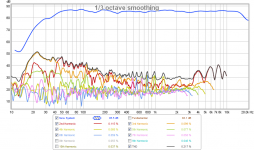 10f-rs225-fast-bw1-550hz-acoustic-system-hd.png198.8 KB · Views: 1,065
10f-rs225-fast-bw1-550hz-acoustic-system-hd.png198.8 KB · Views: 1,065 -
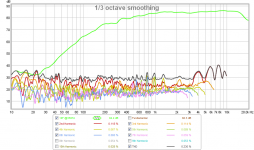 10f-rs225-fast-bw1-550hz-acoustic-10f-hd.png186.3 KB · Views: 1,052
10f-rs225-fast-bw1-550hz-acoustic-10f-hd.png186.3 KB · Views: 1,052 -
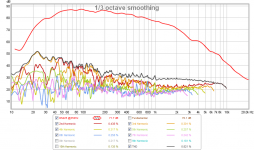 10f-rs225-fast-bw1-550hz-acoustic-rs225-hd.png193.1 KB · Views: 1,055
10f-rs225-fast-bw1-550hz-acoustic-rs225-hd.png193.1 KB · Views: 1,055 -
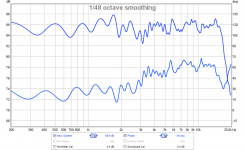 10f-rs225-fast-bw1-550hz-acoustic-system-4ms-gate-hires-spl.png95.2 KB · Views: 1,040
10f-rs225-fast-bw1-550hz-acoustic-system-4ms-gate-hires-spl.png95.2 KB · Views: 1,040 -
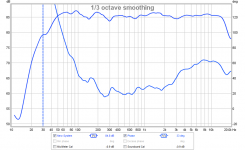 10f-rs225-fast-bw1-550hz-acoustic-system-abs-phase.png78.6 KB · Views: 1,153
10f-rs225-fast-bw1-550hz-acoustic-system-abs-phase.png78.6 KB · Views: 1,153 -
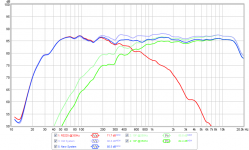 10f-rs225-fast-bw1-550hz-acoustic-system-xo.png95.6 KB · Views: 1,060
10f-rs225-fast-bw1-550hz-acoustic-system-xo.png95.6 KB · Views: 1,060
Looks pretty good X, it looks more balanced to me. Looks like it may be down a bit around 500 which can cause male vocals to sound a little thin. Maybe move the xo down to 300 and you might want a little notch on the 10F at around 1500.
Notice how the summed response came up just a bit in the 50-150 range when the 10f low end was dropped? That says that the 10f is a little out of phase with the dayton down low.
The distortion products do indeed appear to be coming from the 10f. But it's hard to tell how tell how accurate these are at such a low volume. 85db @ .5m is only 79 @1m and in the low 70's at your listening position. Distortion sweeps are typically made at around 90 and 95db 1m equivalent. So around 95-100 or so if your measuring at .5m.
You can measure this more nearfield to reduce the noise floor, but you'll also reduce high frequency accuracy.
You'll notice that the tall order spikes appear in both measurements so this is indeed a box or measurement artifact/limitation like Scott mentioned earlier.
Your step did indeed look a bit better before, but it still looks pretty good to me.
The min phase is deviating quite a bit up high and it seems that this could be improved, but honestly I don't know how to do that. I usually just play until it looks decent. Rew has an option to remove the delay from the minphase, so I think you need to check that box, it'll alter the phase. It's located in the drop down for measurements in the upper right.
You need to adjust the time and db scale on the csd to get anything useful from it
Notice how the summed response came up just a bit in the 50-150 range when the 10f low end was dropped? That says that the 10f is a little out of phase with the dayton down low.
The distortion products do indeed appear to be coming from the 10f. But it's hard to tell how tell how accurate these are at such a low volume. 85db @ .5m is only 79 @1m and in the low 70's at your listening position. Distortion sweeps are typically made at around 90 and 95db 1m equivalent. So around 95-100 or so if your measuring at .5m.
You can measure this more nearfield to reduce the noise floor, but you'll also reduce high frequency accuracy.
You'll notice that the tall order spikes appear in both measurements so this is indeed a box or measurement artifact/limitation like Scott mentioned earlier.
Your step did indeed look a bit better before, but it still looks pretty good to me.
The min phase is deviating quite a bit up high and it seems that this could be improved, but honestly I don't know how to do that. I usually just play until it looks decent. Rew has an option to remove the delay from the minphase, so I think you need to check that box, it'll alter the phase. It's located in the drop down for measurements in the upper right.
You need to adjust the time and db scale on the csd to get anything useful from it
Playing with time delays can probably improve the SR and the phase mismatch at the lower frequencies as you suspect. It's all easy to play around and make tweaks here and there with miniDSP. I can imagine that this would be kind of painful with hard wired passive components.
..... Looks like it may be down a bit around 500 which can cause male vocals to sound a little thin......
Any possibility cause can be the sensitive offset calibration drivers between, below example is just 3 cm offset error blue is LF behind and red is if HF behind or call it delayed.
.....Notice how the summed response came up just a bit in the 50-150 range when the 10f low end was dropped? That says that the 10f is a little out of phase with the dayton down low.....
xrk971 said this "I moved the electrical XO of the 10F up to 350Hz, and padded it down by -1.6dB". Padding down couldn't that be the better bass and think system phase integrate better in the 250Hz 10F setup its flatter and when curve start to rise the natural lag caused by system lowcut is more natural slow rising.
250Hx XO for 10F:

350Hx XO for 10F and padded down 1,6dB:

Playing with time delays can probably improve the SR and the phase mismatch at the lower frequencies as you suspect. It's all easy to play around and make tweaks here and there with miniDSP. I can imagine that this would be kind of painful with hard wired passive components.
Byrtt,
Are you saying you think the 200Hz XO on the 10F is better?
Hi X to rule out offset between drivers and the error in getting nice flat phase from that and plus FR midrange gets a boost or cut suggest this. Data from raw performance each driver should give you a picture to set a best target XO point then take one driver at a time use whatever you want to hit the textbook slope in acoustic domain and doesn't matter if needs Linkwitz transform or weird electric XOs or EQ shelves. Guess you measure far field enough that baffle step loss is corrected for when you hunted the two acoustic textbook slopes. Then when summing the two new slopes two sensitive parameters comes in. One is the correct balance in SPL between HP and LP and is very sensitive and audio able and one is sensitive hunt for best offset between the driver and also very sensitive and audio able.
As final result can end to keep Xmax and HD acceptable that you no more have a 101dB SPL speaker, but it still can get much louder and more low end than a 10F sitting alone as full ranger and still throw a phase plot on axis as a single full ranger.
Subject change:
Think your measured acoustic IR looks nice. See below from the 730Hz XO electric domain with my soundcard the black one is sytem IR then compare to yours.

Last edited:
I'm not sure how the sim works, but you shouldn't be seeing that kinda comb filtering response with the polarity reversed. If you see a perfectly flat line and perfect slopes like that then I would think that you'd see a perfect null. Have you adjusted your acoustic centers. I'd start at maybe -15 to -18mm on the woofer.
Hi satx tried this afternoon at my live system and honestly with BW1 i can switch polarity on woofer or tweeter and FR is exactly the same when measured. When listening one can clear hear FR seems same balance but the transients seems softer and that is visual seen in SR, i could be tempted to say with reversed polarity at one of drivers that it sounds as a 2.order filter 🙂 and what that takes.
Guess if you had experienced such outs with reverse polarity one driver running BW1 that either bandwidth for driver to overlap the other had been rolling off too fast or their acoustic offset had been huge, the such out showed yesterday was with 25" to get the comb filtering effect.
Below XSim simulation with two high bandwidth drivers that fully overlap and their acoustic offset is in sync plus there is no system pass band set. One is both drivers normal polarity the other two either HF or LF driver is reversed. Keep eye the phases each driver and the blue phase line is system phase sum.
Attachments
Hi X to rule out offset between drivers and the error in getting nice flat phase from that and plus FR midrange gets a boost or cut suggest this. Data from raw performance each driver should give you a picture to set a best target XO point then take one driver at a time use whatever you want to hit the textbook slope in acoustic domain and doesn't matter if needs Linkwitz transform or weird electric XOs or EQ shelves. Guess you measure far field enough that baffle step loss is corrected for when you hunted the two acoustic textbook slopes. Then when summing the two new slopes two sensitive parameters comes in. One is the correct balance in SPL between HP and LP and is very sensitive and audio able and one is sensitive hunt for best offset between the driver and also very sensitive and audio able.
As final result can end to keep Xmax and HD acceptable that you no more have a 101dB SPL speaker, but it still can get much louder and more low end than a 10F sitting alone as full ranger and still throw a phase plot on axis as a single full ranger.
Subject change:
Think your measured acoustic IR looks nice. See below from the 730Hz XO electric domain with my soundcard the black one is sytem IR then compare to yours.


Your image link doesn't work for some reason.
I think what you are saying is to work each one individually to get best textbook response and balance SPL and time delays to achieve best integration.
Image links seems okay in my browser.Your image link doesn't work for some reason.
I think what you are saying is to work each one individually to get best textbook response and balance SPL and time delays to achieve best integration.
Right because those last two settings just bit wrong confuse one to begin tweak the electric XO again when summing is not ok. Therefor take time get HP and LP slopes most precise textbook acoustic think at least three octaves or better from the XO point you settled on. Then if errors when summing it must be because of the last two that is sensitive parameters to calibrate precise. A little helper for the SPL balance set right or close between them is to measure HP a LP section separate and overlay those two in REW then their XO point should be close to what you targeted slopes. When being close guess measure squarer wave reproduction is a helper too.
Any possibility cause can be the sensitive offset calibration drivers between, below example is just 3 cm offset error blue is LF behind and red is if HF behind or call it delayed.

xrk971 said this "I moved the electrical XO of the 10F up to 350Hz, and padded it down by -1.6dB". Padding down couldn't that be the better bass and think system phase integrate better in the 250Hz 10F setup its flatter and when curve start to rise the natural lag caused by system lowcut is more natural slow rising.
250Hx XO for 10F:

350Hx XO for 10F and padded down 1,6dB:

Not sure I totally understand and your 1st picture didn't load, but yes I think the sensitivities were off before. I didn't recommend padding it down, but just raise xo slightly because I figured he wanted to keep the rising response up top so it's more extended off axis.
I agree that the min phase and probably step response was a bit better before. More work probably still needs to be done. I still think that 300-350xo on the 10F is an improvment both in frequency response, phase and power handling/distortion.
Hi satx tried this afternoon at my live system and honestly with BW1 i can switch polarity on woofer or tweeter and FR is exactly the same when measured. When listening one can clear hear FR seems same balance but the transients seems softer and that is visual seen in SR, i could be tempted to say with reversed polarity at one of drivers that it sounds as a 2.order filter 🙂 and what that takes.
Guess if you had experienced such outs with reverse polarity one driver running BW1 that either bandwidth for driver to overlap the other had been rolling off too fast or their acoustic offset had been huge, the such out showed yesterday was with 25" to get the comb filtering effect.
Below XSim simulation with two high bandwidth drivers that fully overlap and their acoustic offset is in sync plus there is no system pass band set. One is both drivers normal polarity the other two either HF or LF driver is reversed. Keep eye the phases each driver and the blue phase line is system phase sum.
I don't have too much personal experience with first order crossovers so if your sim is telling you something different then I'd go with that. As long as you're using good data and doing it right.
I still find it strange that you would get no change in response with polarity flipped. You are flipping phase a full 180 so if it's in phase at one then it should be out of phase the other way. Unless of course the phase isn't good to begin with- say your at 90 both ways or something?
Image links seems okay in my browser.
Right because those last two settings just bit wrong confuse one to begin tweak the electric XO again when summing is not ok. Therefor take time get HP and LP slopes most precise textbook acoustic think at least three octaves or better from the XO point you settled on. Then if errors when summing it must be because of the last two that is sensitive parameters to calibrate precise. A little helper for the SPL balance set right or close between them is to measure HP a LP section separate and overlay those two in REW then their XO point should be close to what you targeted slopes. When being close guess measure squarer wave reproduction is a helper too.
Not working for me either.
I agree, but it's kind of a balancing act where if you adjust one then the other will probably need adjusting. But yes get your slopes right and hit your xo target then adjust delay. BTW, sometimes you need to deviate slightly from textbook slopes to hit summed response target and proper phase.
- Home
- Loudspeakers
- Full Range
- 10F/8424 & RS225-8 FAST / WAW Ref Monitor
